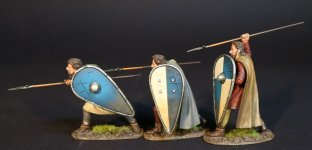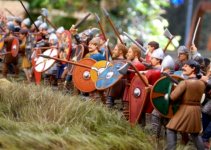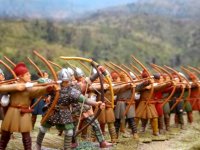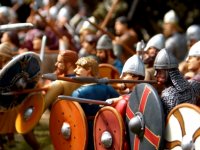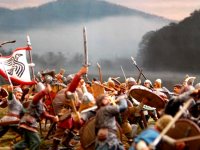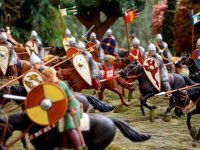- Joined
- Feb 2, 2011
- Messages
- 2,093
NEW RELEASES FOR APRIL 2024
THE AGE OF ARTHUR
THE NORMANS

The 1066 Norman army included many groups of knights who were trained to fight side by side under the same leaders. This meant they were disciplined and skilled in co-ordinating “feigned flight”, and then turning and cutting down their pursuers.
All the sources agree that the battle of Hastings was a very bloody affair.
The Battle began at 9am on Saturday 14[SUP]th[/SUP] October 1066, and both sides were still engaged at dusk, which was around 5pm.
The Anglo-Saxon Chronicle, speaks of “great slaughter on both sides”.
William of Poitiers, describing the aftermath, wrote that “far and wide, the earth was covered with the flower of the English nobility and youth, drenched in blood”.
For the Godwinson family in particular the battle was catastrophic, for not only King Harold, but two of his younger brothers, Leofwine and Gyrth, were among the fallen. (Another brother, Tostig, had been killed three weeks earlier at Stamford Bridge).
It is estimated that the Norman Army 7,000 strong, suffered around 2,000 casualties.
EUROPEAN ALLIED INFANTRY
Eustace II, Count of Boulogne
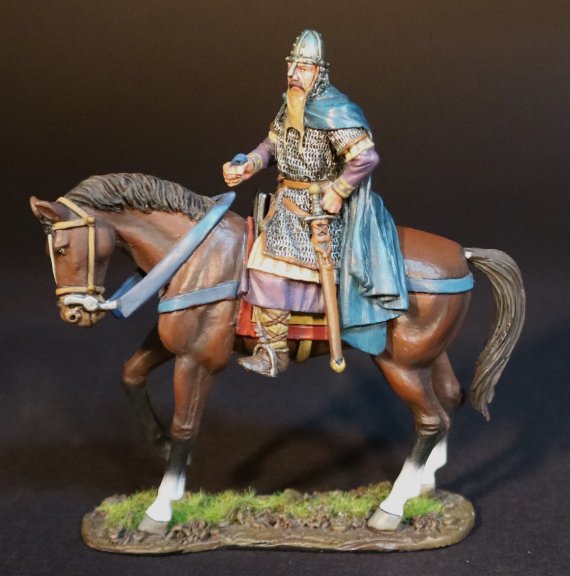
NM-17
THE AGE OF ARTHUR,
THE NORMAN ARMY,
Eustace II, Count of Boulogne.
Eustace II, Count of Boulogne (c. 1015 – 1087) also known as Eustace aux Grenons (Eustace with long moustaches) was the Count of Boulogne from 1049 – 1087. He fought on the Norman side at the battle of Hastings, and was an important participant in the Norman conquest of England.
Sources vary regarding the details of his conduct during the Battle of Hastings, but it must have been significant as afterwar the battle he received large grants of land. It has also been suggested that Eustace was the patron of the Bayeux Tapestry.
French Infantrymen of this period that accompanied the Norman army at Hastings were armed with spear and shield, which were the standard arms of the general levy. The winged spearhead is derived from the Carolingian period, the function of the wings was to prevent the spear head from penetrating too far.
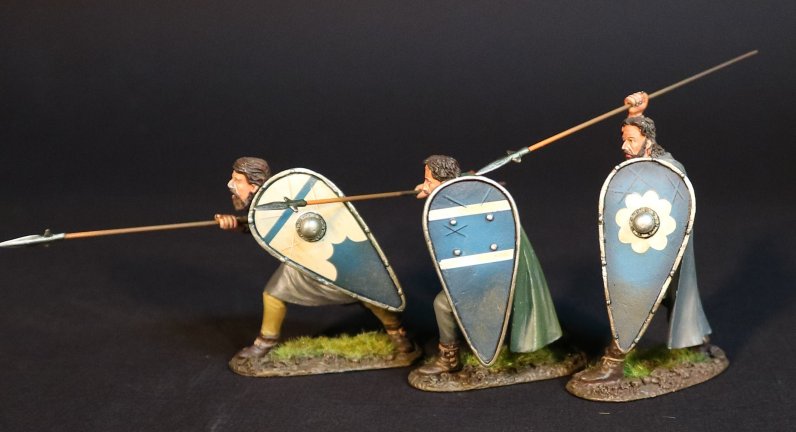
NM-18A
THE AGE OF ARTHUR,
THE NORMAN ARMY,
EUROPEAN ALLIED INFANTRY,
FRENCH SPEARMEN.
(6 pcs)
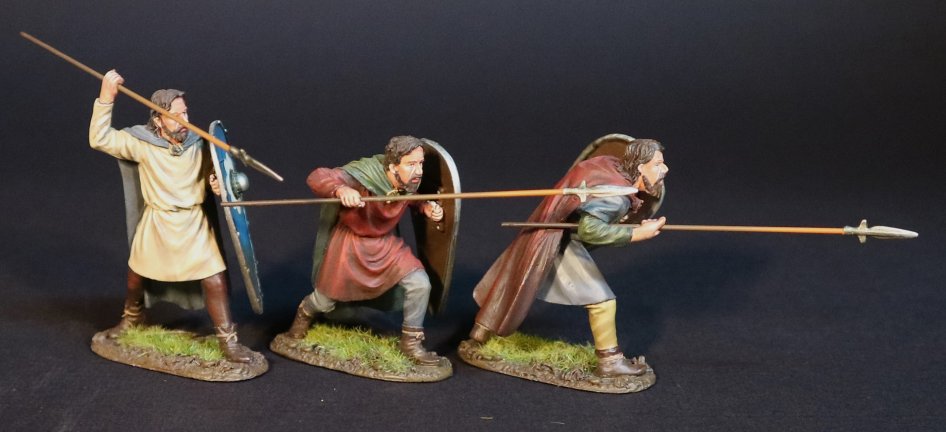
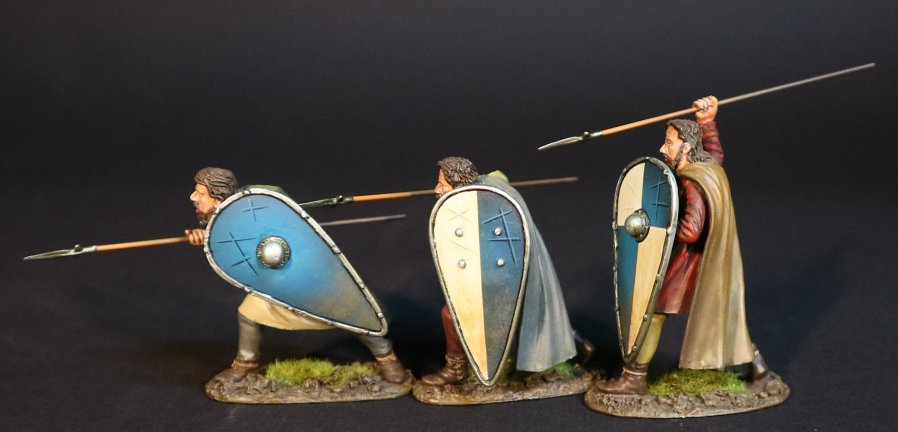
NM-18B
THE AGE OF ARTHUR,
THE NORMAN ARMY,
EUROPEAN ALLIED INFANTRY,
FRENCH SPEARMEN.
(6 pcs)
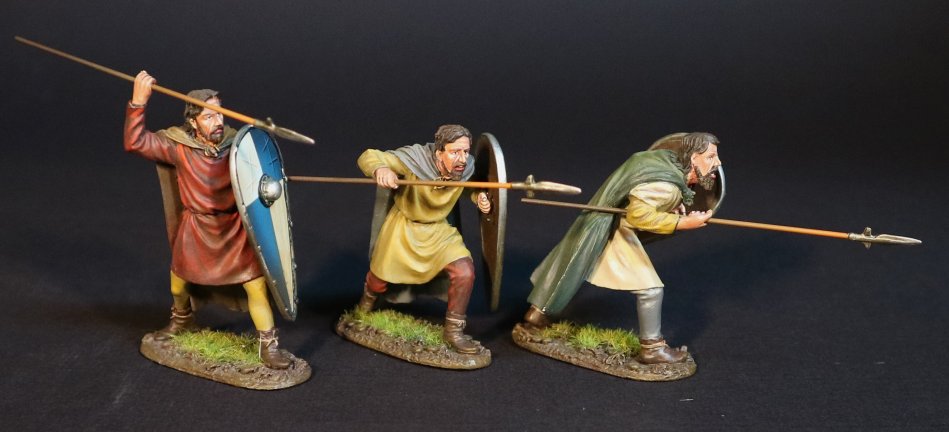
** PLEASE CONTACT YOUR LOCAL DEALER FOR FURTHER INFORMATION**
THE AGE OF ARTHUR
THE NORMANS

The 1066 Norman army included many groups of knights who were trained to fight side by side under the same leaders. This meant they were disciplined and skilled in co-ordinating “feigned flight”, and then turning and cutting down their pursuers.
All the sources agree that the battle of Hastings was a very bloody affair.
The Battle began at 9am on Saturday 14[SUP]th[/SUP] October 1066, and both sides were still engaged at dusk, which was around 5pm.
The Anglo-Saxon Chronicle, speaks of “great slaughter on both sides”.
William of Poitiers, describing the aftermath, wrote that “far and wide, the earth was covered with the flower of the English nobility and youth, drenched in blood”.
For the Godwinson family in particular the battle was catastrophic, for not only King Harold, but two of his younger brothers, Leofwine and Gyrth, were among the fallen. (Another brother, Tostig, had been killed three weeks earlier at Stamford Bridge).
It is estimated that the Norman Army 7,000 strong, suffered around 2,000 casualties.
EUROPEAN ALLIED INFANTRY
Eustace II, Count of Boulogne

NM-17
THE AGE OF ARTHUR,
THE NORMAN ARMY,
Eustace II, Count of Boulogne.
Eustace II, Count of Boulogne (c. 1015 – 1087) also known as Eustace aux Grenons (Eustace with long moustaches) was the Count of Boulogne from 1049 – 1087. He fought on the Norman side at the battle of Hastings, and was an important participant in the Norman conquest of England.
Sources vary regarding the details of his conduct during the Battle of Hastings, but it must have been significant as afterwar the battle he received large grants of land. It has also been suggested that Eustace was the patron of the Bayeux Tapestry.
French Infantrymen of this period that accompanied the Norman army at Hastings were armed with spear and shield, which were the standard arms of the general levy. The winged spearhead is derived from the Carolingian period, the function of the wings was to prevent the spear head from penetrating too far.

NM-18A
THE AGE OF ARTHUR,
THE NORMAN ARMY,
EUROPEAN ALLIED INFANTRY,
FRENCH SPEARMEN.
(6 pcs)


NM-18B
THE AGE OF ARTHUR,
THE NORMAN ARMY,
EUROPEAN ALLIED INFANTRY,
FRENCH SPEARMEN.
(6 pcs)

** PLEASE CONTACT YOUR LOCAL DEALER FOR FURTHER INFORMATION**


